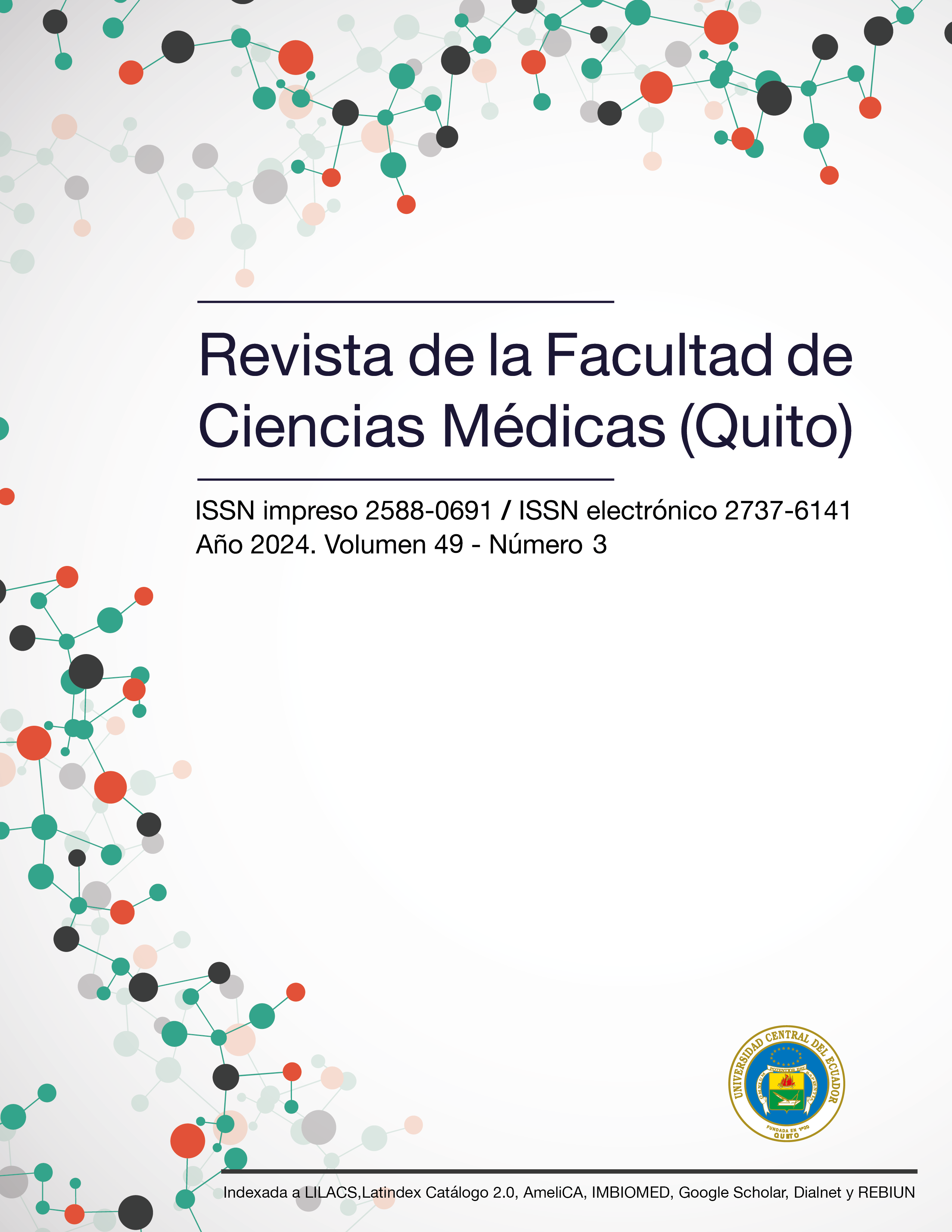Diagnostico e intervención quirúrgica para nasoangiofibroma juvenil recidivante. Reporte de caso.
DOI:
https://doi.org/10.29166/rfcmq.v49i3.6686Palabras clave:
angiofibroma, obstrucción nasal, epistaxis, neoplasias nasalesResumen
Introducción: Los angiofibromas son tumores fibrosos benignos altamente expansivos originados en la región esfenopalatina, a nivel del canal palatovaginal, con doble aporte sanguíneo tanto de la maxilar interna y sus ramas, como esporádicamente de arterias de la carótida interna (arteria vidiana). El estudio de este reporte es valioso ya que explica la formación y manejo en su inicio y en la recidiva, aportando datos específicos para ser comparado con otros estudios y como método de consulta.
Objetivo: El objetivo fue describir un caso de recidiva de nasoangiofibroma juvenil determinando las características de este tumor, rasgos de recidiva, tratamiento apropiado y pronóstico de vida.
Presentación del caso: Se trata de un paciente de 16 años, quien presentó episodios de epistaxis a repetición aproximadamente de 2 años de evolución, acompañado de sensación de obstrucción nasal. Mediante angiotomografía, se evidencia una masa tumoral que se la cataloga como un Nasoangiofibroma Juvenil Radkoswki III-A, por lo que se decide realizar exéresis del mismo. Posteriormente se evidencia una recidiva que requiere un nuevo manejo clínico y quirúrgico, con evolución favorable.
Discusión: El nasoangiofibroma juvenil a pesar de ser un tumor benigno, es muy fibroso y vascularizado, y depende de su sitio de crecimiento e implantación para determinar la posibilidad o no de recidiva.
Conclusiones: El manejo de dichos tumores debería ser mediante microscopía, ya que, por su extensión, ubicación particular, la vascularización y su tejido fibroso presente en la recidiva, responden de mejor manera a esta técnica.
Descargas
Métricas
Citas
Reyes C, Bentley H, Gelves JA, Solares CA, Byrd JK. Recurrence Rate after Endoscopic vs. Open Approaches for Juvenile Nasopharyngeal Angiofibroma: A Meta-analysis. Journal of Neurological Surgery Part B: Skull Base[Internet]. 2018 [cited 2024 Sep 6]; 80(06): 577-585. Available from: https://doi.org/10.1055/s-0038- 1676562.
Llorente JL, López F. The endoscopic endonasal approach for the treatment of juvenile angiofibromas. Acta Otorrinolaringol Engl Ed [Internet]. 2019[cited 2024 Sep 6];70(3):136–44. Available from: http://dx.doi.org/10.1016/j.otoeng.2018.01.004.
Alshaikh NA, Eleftheriadou A. Juvenile nasopharyngeal angiofibroma staging: An overview. Ear Nose Throat J [Internet]. 2015[cited 2024 Sep 6];94(6):E12–22. Available from: http://dx.doi.org/10.1177/014556131509400615.
Mishra A, Pandey A, Mishra SC. Variable expression of molecular markers in juvenile nasopharyngeal angiofibroma. J Laryngol Otol [Internet]. 2017[cited 2024 Sep 6];131(9):752–9. Available from: http://dx.doi.org/10.1017/s0022215117001372.
Kairo AK, Kumar R, Sharma SC. Can palatovaginal canal be the site of origin of juvenile nasopharyngeal angiofibroma? Med Hypotheses [Internet]. 2020[cited 2024 Sep 6];144(110300):110300. Available from: http://dx.doi.org/10.1016/j.mehy.2020.110300.
Midilli R, Karci B, Akyildiz S. Juvenile nasopharyngeal angiofibroma: Analysis of 42 cases and important aspects of endoscopic approach. Int J Pediatr Otorhinolaryngol [Internet]. 2009[cited 2024 Sep 6];73(3):401–8. Available from: http://dx.doi.org/10.1016/j.ijporl.2008.11.005.
Mishra A, Mishra SC. Changing trends in the incidence of juvenile nasopharyngeal angiofibroma: seven decades of experience at King George’s Medical University, Lucknow, India. J Laryngol Otol [Internet]. 2016[cited 2024 Sep 6];130(4):363–8. Available from: http://dx.doi.org/10.1017/S0022215116000268.
Serrano F, Serrano M, Serrano E, Zurita H, Chávez L. Ventajas de la Técnica Combinada de Rouge-Denker en el Manejo Quirúrgico del Angiofibroma Juvenil: Incidencia y Prevalencia. Rev.Ac. Ec. ORL. 2006;5(1):23-27.
Liu Z, Hua W, Zhang H, Wang J, Song X, Hu L, et al. The risk factors for residual juvenile nasopharyngeal angiofibroma and the usual residual sites. Am J Otolaryngol [Internet]. 2019[cited 2024 Sep 6];40(3):343–6. Available from: http://dx.doi.org/10.1016/j.amjoto.2018.11.010.
Jaiswal AS, Kumar R, Thakar A, Kumar R, Verma H, Bhalla AS, et al. Plasma ablation-assisted endoscopic excision versus traditional technique of endoscopic excision of juvenile nasopharyngeal angiofibroma. Int J Pediatr Otorhinolaryngol [Internet]. 2020[cited 2024 Sep 6];139(110410):110410. Available from: http://dx.doi.org/10.1016/j.ijporl.2020.110410.
Snyderman C, Harshita P, Carrau R, Gardner P. A New Endoscopic Stating System for Angiofibromas. Arch otolaryngol head neck. University of Pittsburgh School of Medicine, Pittsburgh, Pennsylvania; and Department of Otolaryngology–Head and Neck Surgery[Internet]. 2019[cited 2024 Sep 6];136(6):588-594. Available from: https://doi: 10.1055/s-0038-1676305.
Boghani Z, Husain Q, Kanumuri VV, Khan MN, Sangvhi S, Liu JK, et al. Juvenile nasopharyngeal angiofibroma: a systematic review and comparison of endoscopic, endoscopic-assisted, and open resection in 1047 cases: Systematic review of JNA. Laryngoscope [Internet]. 2013[cited 2024 Sep 6];123(4):859–69. Available from: http://dx.doi.org/10.1002/lary.23843.
Khoueir N, Nicolas N, Rohayem Z, Haddad A, Abou Hamad W. Exclusive endoscopic resection of juvenile nasopharyngeal angiofibroma: A systematic review of the literature. Otolaryngol Head Neck Surg [Internet]. 2014[cited 2024 Sep 6];150(3):350–8. Available from: http://dx.doi.org/10.1177/0194599813516605.
Pool C, Gates CJ, Patel VA, Carr MM. Juvenile nasopharyngeal angiofibroma: National practice patterns and resource utilization via HCUP KID. Int J Pediatr Otorhinolaryngol [Internet]. 2021[cited 2024 Sep 6];149(110871):110871. Available from: http://dx.doi.org/10.1016/j.ijporl.2021.110871.
Pamuk AE, Özer S, Süslü AE, Akgöz A, Önerci M. Juvenile nasopharyngeal angiofibroma: a single centre’s 11-year experience. J Laryngol Otol [Internet]. 2018[cited 2024 Sep 6];132(11):978–83. Available from: http://dx.doi.org/10.1017/s0022215118001779
Descargas
Publicado
Cómo citar
Número
Sección
Licencia
Derechos de autor 2024 Juan Esteban Serrano-Sáenz , Priscila Monserrate Cisneros-Andrade

Esta obra está bajo una licencia internacional Creative Commons Atribución-NoComercial-SinDerivadas 4.0.











